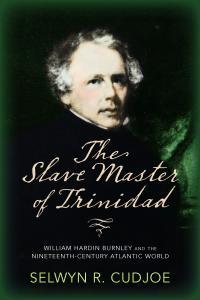Reparative Justice
By Dr Selwyn R. Cudjoe
October 01, 2018
When we think of restorative justice we must think of who was harmed and how we make them whole again.
—Marc Lamont Hill, 2018
On November 23, 1850, the San Fernando Gazette announced the death of John Lamont, the second-largest slave owner in the island. It noted: "Mr. Lamont had arrived at the age of 65, the largest part of which he passed in this island [or Trinidad] where he had accumulated a very large fortune, by care, perseverance, and intelligence, accompanied by the strictest integrity, and marked by humor in all his transactions."
Lamont arrived in Trinidad in 1802 and acquired several estates. In 1849 he purchased Benmore, a large estate in Toward, Scotland, for £13,000 on which he built Benmore House. Today, it's a part of the Royal Botanical Garden of Scotland in Loch Lomond and the Trossachs National Park. That facility was built from the stolen labor of the enslaved people of Trinidad and Tobago.
In August 2013 I visited Benmore House and the Royal Botanical Garden with Dr. Stephen Mullen, a joint-author "Slavery, Abolition and the University of Glasgow," a report on how the profits of slaves supported that institution.
On September 17, 2018, the London Guardian announced Glasgow University's plans "to make amends over slavery profits of the past." The story read: "Glasgow University has announced a program of 'reparative justice' after a year-long study discovered that the university benefited from the equivalent of tens of millions of pounds donated from the profits of slavery." Both Edmund Burke and Adam Smith were Rectors of the University.
William Hardin Burnley, Trinidad's biggest slave owner, owned 14 sugar estates, the largest of which were Providence in the South and Orange Grove in the north with 234 and 202 enslaved people respectively. His son, William Frederick Burnley, inherited most of his father's fortune. He lived in Glasgow, Scotland and became "a partner in the Glasgow-Trinidad based firm Eccles, Burnley & Co. and consolidated the connection by marrying Rosina Eccles, one of the main partner's daughter" (Slavery, Abolition and the University of Glasgow.) He contributed £2,100 to the University of Glasgow.
Cudjoe, my great-grandfather and Moriah Cudjoe, my great-grandmother were born in Tacarigua in 1833 and 1837 respectively. Their son, Robert James Cudjoe (b. 1876), and many of his grandchildren, worked on Burnley's estate whose name was changed to the Trinidad Sugar Estates (TSE). I still remember seeing my grandfather, hunched over his bicycle, riding to work to "the factory" five days a week.
The land is now leased by Dominick Hadeed and goes under the name of Blue Waters. Eziz Hadeed, Dominick's father, came from Syria in the 1960s and started selling clothes. Later, he founded the Fabric Land chain of stores. In 1996 he founded Blue Waters which was located originally at Trincity Industrial Estate.
In 2006 Blue Waters bought out the rights of Pernod Ricard, a French firm, which had leased 285 acres of Orange Grove lands (Burnley's lands) on which it cultivated aniseed, an ingredient that was used in the making of wines. Blue Waters uses the site on which the old factory was located to produce their bottled waters and planted the rest of the land in over two dozen types of long and medium crops.
In 1955 Eric Williams began to spread his nationalist message, "Massa Day Done," that preached a gospel of land reform and the cultivation of self-respecting citizens. My parents and neighbors embraced that message of liberation.
Victor Bailey, my next door neighbor and factory worker at TSE, was one of the first persons to embrace the teaching of this anti-colonial movement. He supported the candidacy of McDonald Stanley, a chief lieutenant of Uriah "Buzz" Butler, who fought Badase Sagan Maraj for the Tunapuna seat in 1956 and lost.
Bailey supported Williams. In 1955 he had the audacity to stand on the steps of St. Mary's A. C. School, Tacarigua, and chair a PNM meeting that Williams addressed. The next day William "Billy" Howard, general manager of the TSE, called Bailey into his office and scolded him for supporting Williams's communist movement. Howard ended his conversation by telling Bailey: "The next time you chair such a meeting you can look for another job."
Many of our parents bought their little plots from the TSE when it went out of business in the 1960s, just about the time Hadeed arrived in our midst. Today, Hadeed continues to exploit the land upon which so many of our ancestors worked and sweated and whose children continue to struggle to make a living.
Public and private institutions all over the world are waking up to their obligation to those people who have been exploited over the past three hundred years. They are trying to repair and repay for the past injustices they have inflicted upon defenseless people. They call this process reparative justice.
I wonder if the echoes of that movement have begun to manifest themselves in chambers of government and private enterprise. In other words, how can our leaders of government and private enterprise engage in acts of reparative justice that acknowledge the damage that so many years of deprivation have caused the children and grandchildren of the formerly enslaved and indentured men and women, especially when they give out these franchises and leases?
Selwyn R. Cudjoe's email address is scudjoe@wellesley.edu. He can be reached @ProfessorCudjoe.
Share your views here...

The Slave Master of Trinidad by Dr. Selwyn R. Cudjoe
|

